Games on Climate Change: Identifying Development Potentials through Advanced Classification and Game Characteristics Mapping
Abstract
1. Introduction
- Identifying climate games that have been released during recent years;
- Providing an overview of characteristics of the identified games by classifying them according to a newly developed typology;
- Identifying gaps and potential areas where future climate games could contribute to solve climate related challenges.
2. Materials and Methods
2.1. Typology Development
2.2. Mapping Review
2.2.1. Searching for Climate Games
2.2.2. Screening and Selecting Climate Games
2.2.3. Classifying the Identified Climate Games
2.2.4. Extracting and Mapping Data
3. Results
3.1. Game Typology
3.2. Overview of the Identified Climate Games
3.3. Characteristics of the Identified Climate Games
3.4. Mapping of Game Characteristics
4. Discussion
4.1. Game Typology
4.2. Identification of Climate Games
4.3. Characteristics of the Identified Climate Games
4.4. Mapping of Game Characteristics
4.5. Potential Areas to Be Explored by Future Climate Games
5. Conclusions
Supplementary Materials
Author Contributions
Funding
Data Availability Statement
Acknowledgments
Conflicts of Interest
References
- IPCC. Summary for policymakers. In Climate Change 2014: Impacts, Adaptation, and Vulnerability. Part A: Global and Sectoral Aspects. Contribution of Working Group II to the Fifth Assessment Report of the Intergovernmental Panel on Climate Change; Field, C.B., Barros, V.R., Dokken, D.J., Mach, K.J., Mastrandrea, M.D., Bilir, T.E., Chatterjee, M., Ebi, K.L., Estrada, Y.O., Genova, R.C., et al., Eds.; Cambridge University Press: Cambridge, UK; New York, NY, USA, 2014. [Google Scholar]
- IPCC. Summary for Policymakers. In Global Warming of 1.5°C. An IPCC Special Report on the Impacts of Global Warming of 1.5 °C above Pre-Industrial Levels and Related Global Greenhouse Gas Emission Pathways, in the Context of Strengthening the Global Response to the Threat of Climate Change, Sustainable Development, and Efforts to Eradicate Poverty; Masson-Delmotte, V., Zhai, P., Pörtner, H.-O., Roberts, D., Skea, J., Shukla, P.R., Pirani, A., Moufouma-Okia, W., Péan, C., Pidcock, R., et al., Eds.; World Meteorological Organization: Geneva, Switzerland, 2018. [Google Scholar]
- Schneidewind, P.D.U.; Wiegandt, K.; Welzer, P.D.H. Die Große Transformation: Eine Einführung in die Kunst Gesellschaftlichen Wandels; FISCHER E-Books: Frankfurt am Main, Germany, 2018. [Google Scholar]
- Schneidewind, U. Transformative Literacy. Understanding and Shaping Societal Transformations. GAIA 2013, 22, 82–86. [Google Scholar] [CrossRef]
- Schneidewind, U.; Singer-Brodowski, M. Enabling the great transformation: Transdisciplinarity as individual and institutional challenge. In Contributions towards a Sustainable World: In Dialogue with Klaus Töpfer; Schmidt, F., Ed.; Oekom-Verlag: München, Germany, 2014; pp. 189–200. [Google Scholar]
- Moxnes, E.; Saysel, A.K. Misperceptions of global climate change: Information policies. Clim. Chang. 2008, 93, 15–37. [Google Scholar] [CrossRef]
- Sterman, J.D.; Sweeney, L.B. Cloudy skies: Assessing public understanding of global warming. Syst. Dyn. Rev. 2002, 18, 207–240. [Google Scholar] [CrossRef]
- Sterman, J.; Fiddaman, T.; Franck, T.; Jones, A.; McCauley, S.; Rice, P.; Sawin, E.; Siegel, L. Climate interactive: The C-ROADS climate policy model. Syst. Dyn. Rev. 2012, 28, 295–305. [Google Scholar] [CrossRef]
- Meya, J.N.; Eisenack, K. Effectiveness of gaming for communicating and teaching climate change. Clim. Chang. 2018, 149, 319–333. [Google Scholar] [CrossRef]
- Rajanen, D.; Rajanen, M. Climate change gamification: A literature review. In Proceedings of the GamiFIN Conference 2019, Levi, Finland, 8–10 April 2019. [Google Scholar]
- Rooney-Varga, J.N.; Kapmeier, F.; Sterman, J.D.; Jones, A.P.; Putko, M.; Rath, K. The Climate Action Simulation. Simul. Gaming 2019, 51, 114–140. [Google Scholar] [CrossRef]
- Wu, J.S.; Lee, J.J. Climate change games as tools for education and engagement. Nat. Clim. Chang. 2015, 5, 413–418. [Google Scholar] [CrossRef]
- Ulrich, M.; Zemp, M. Führen in Expertenorganisationen—Eine didaktische Perspektive mit praktischer Anleitung. In Experten Führen. Modelle, Ideen und Praktiken für die Organisations- und Führungsentwicklung; Kels, P., Kaudela-Baum, S., Eds.; Springer: Wiesbaden, Germany, 2019. [Google Scholar]
- Duke, R. Gaming: The Future’s Language, 2nd ed.; W. Bertelsmann Verlag: Bielefeld, Germany, 2014. [Google Scholar]
- Katsaliaki, K.; Mustafee, N. Edutainment for Sustainable Development:A Survey of Games in the Field. Simul. Gaming 2015, 46, 647–672. [Google Scholar] [CrossRef]
- Ulrich, M. Games/Simulations About Environmental Issues—Existing Tools and Underlying Concepts. In Proceedings of the 28th Annual Conference of the International Simulation and Gaming Association, Tilburg, The Netherlands, 7–11 July 1997; pp. 301–311. [Google Scholar]
- Capellán-Pérez, I.; Álvarez-Antelo, D.; Miguel, L.J. Global Sustainability Crossroads: A Participatory Simulation Game to Educate in the Energy and Sustainability Challenges of the 21st Century. Sustainability 2019, 11, 3672. [Google Scholar] [CrossRef]
- Reckien, D.; Eisenack, K. Climate Change Gaming on Board and Screen: A Review. Simul. Gaming 2013, 44, 253–271. [Google Scholar] [CrossRef]
- Flood, S.; Cradock-Henry, N.A.; Blackett, P.; Edwards, P. Adaptive and interactive climate futures: Systematic review of ‘serious games’ for engagement and decision-making. Environ. Res. Lett. 2018, 13, 063005. [Google Scholar] [CrossRef]
- McGonigal, J. Reality Is Broken: Why Games Make Us Better and How They Can Change the World; The Penguin Press: New York, NY, USA, 2011. [Google Scholar]
- Romero, M.; Usart, M.; Ott, M. Can Serious Games Contribute to Developing and Sustaining 21st-Century Skills? Games Cult. J. Interact. Media 2014, 10. [Google Scholar] [CrossRef]
- Gerber, A.; Ulrich, M.; Wäger, P. Review of Haptic and Computerized (Simulation) Games on Climate Change. In Proceedings of the 28th Annual Conference of the International Simulation and Gaming Association, Warsaw, Poland, 26–30 August 2019. [Google Scholar]
- Abt, C.C. Serious Games; Viking: New York, NY, USA, 1970. [Google Scholar]
- Crookall, D. Serious Games, Debriefing, and Simulation/Gaming as a Discipline. Simul. Gaming 2010, 41, 898–920. [Google Scholar] [CrossRef]
- Capaul, R.; Ulrich, M. Planspiele—Simulationsspiele für Training und Unterricht, 2nd ed.; Tobler Verlag AG: Altsätten, Switzerland, 2010. [Google Scholar]
- Duke, R.; Geurts, J. Policy Games for Strategic Management. Pathways into the Unknown.; Dutch University Press: Amsterdam, The Netherlands, 2004. [Google Scholar]
- Robson, K.; Plangger, K.; Kietzmann, J.H.; McCarthy, I.; Pitt, L. Is it all a game? Understanding the principles of gamification. Bus. Horiz. 2015, 58, 411–420. [Google Scholar] [CrossRef]
- Djaouti, D.; Alvarez, J.; Jessel, J.-P. Classifying Serious Games: The G/P/S model. Handb. Res. Improv. Learn. Motiv. Educ. Games Multidiscip. Approaches 2011. [Google Scholar] [CrossRef]
- Prieto, R.; Medina, N. A Comprehensive Taxonomy for Serious Games. J. Educ. Comput. Res. 2016, 55. [Google Scholar] [CrossRef]
- Smedstad, S.M.; Sunnanå, L.; Aarseth, E.J. A Typology of Mobile Games. In Proceedings of the DiGRA International Conference: Level Up, Utrecht, The Netherlands, 4–6 November 2003. [Google Scholar]
- Pe-Than, E.P.P.; Goh, D.H.-L.; Lee, C.S. A typology of human computation games: An analysis and a review of current games. Behav. Inf. Technol. 2015, 34, 809–824. [Google Scholar] [CrossRef]
- Gredler, M. Designing and Evaluating Games and Simulations—A Process Approach; Kogan Page Limited: London, UK, 1992. [Google Scholar]
- Lim, D.H.; Yoon, S.W.; Son, S.J.; Park, S. Typology of Learning Outcomes in Cognitive Domain: What Is Said vs. What Is Measured. In Proceedings of the International Research Conference in the Americas of the Academy of Human Resource Development, Indianapolis, IN, USA, 28 February–4 March 2007. [Google Scholar]
- Petersen, K.; Vakkalanka, S.; Kuzniarz, L. Guidelines for conducting systematic mapping studies in software engineering: An update. Inf. Softw. Technol. 2015, 64, 1–18. [Google Scholar] [CrossRef]
- Moher, D.; Liberati, A.; Tetzlaff, J.; Altman, D.G.; The, P.G. Preferred Reporting Items for Systematic Reviews and Meta-Analyses: The PRISMA Statement. PLoS Med. 2009, 6, e1000097. [Google Scholar] [CrossRef]
- Grant, M.J.; Booth, A. A typology of reviews: An analysis of 14 review types and associated methodologies. Health Inf. Libr. J. 2009, 26, 91–108. [Google Scholar] [CrossRef]
- Stanitsas, M.; Kirytopoulos, K.; Vareilles, E. Facilitating sustainability transition through serious games: A systematic literature review. J. Clean. Prod. 2019, 208, 924–936. [Google Scholar] [CrossRef]
- Petersen, K.; Feldt, R.; Mujtaba, S.; Mattsson, M. Systematic Mapping Studies in Software Engineering. In Proceedings of the 12th International Conference on Evaluation and Assessment in Software Engineering, Bari, Italy, 26–27 June 2008. [Google Scholar]
- d’Aquino, P.; Bah, A. Land Policies for Climate Change Adaptation in West Africa:A Multilevel Companion Modeling Approach. Simul. Gaming 2013, 44, 391–408. [Google Scholar] [CrossRef]
- Valkering, P.; van der Brugge, R.; Offermans, A.; Haasnoot, M.; Vreugdenhil, H. A Perspective-Based Simulation Game to Explore Future Pathways of a Water-Society System Under Climate Change. Simul. Gaming 2013, 44, 366–390. [Google Scholar] [CrossRef]
- Lebel, P.; Sriyasak, P.; Kallayanamitra, C.; Duangsuwan, C.; Lebel, L. Learning about climate-related risks: Decisions of Northern Thailand fish farmers in a role-playing simulation game. Reg. Environ. Chang. 2016, 16, 1481–1494. [Google Scholar] [CrossRef]
- Velazquez-Pimentel, D.; Hurkxkens, T.; Nehme, J. A Virtual Reality for the Digital Surgeon. In Digital Surgery; Atallah, S., Ed.; Springer International Publishing: Cham, Switzerland, 2021; pp. 183–201. [Google Scholar] [CrossRef]
- Patt, A. Beyond the tragedy of the commons: Reframing effective climate change governance. Energy Res. Soc. Sci. 2017, 34, 1–3. [Google Scholar] [CrossRef]
- Solinska-Nowak, A.; Magnuszewski, P.; Curl, M.; French, A.; Keating, A.; Mochizuki, J.; Liu, W.; Mechler, R.; Kulakowska, M.; Jarzabek, L. An overview of serious games for disaster risk management—Prospects and limitations for informing actions to arrest increasing risk. Int. J. Disaster Risk Reduct. 2018, 31, 1013–1029. [Google Scholar] [CrossRef]
- Wang, R.; DeMaria, S.J.; Goldberg, A.; Katz, D. A Systematic Review of Serious Games in Training Health Care Professionals. Simul. Healthc. 2016, 11, 41–51. [Google Scholar] [CrossRef] [PubMed]
- Breuer, F. Playing in the narrative space. In Why Do Games Work; In Search of the Active Substance; de Caluwé, L., Hofstede, G.J., Peters, V., Eds.; Kluwer: Deventer, The Netherlands, 2008; pp. 117–129. [Google Scholar]
- Peters, V.; van de Westelaken, M. The management approach: Thinking in systems. In Why Do Games Work; In Search of the Active Substance; de Caluwé, L., Hofstede, G.J., Peters, V., Eds.; Kluwer: Deventer, The Netherlands, 2008; pp. 64–151. [Google Scholar]
- Reinecke, L. Games at work: The recreational use of computer games during working hours. Cyberpsychol. Behav. Impact Internet Multimed. Virtual Real. Behav. Soc. 2009, 12, 461–465. [Google Scholar] [CrossRef]
- Mayer, I.S. The Gaming of Policy and the Politics of Gaming: A Review. Simul. Gaming 2009, 40, 825–862. [Google Scholar] [CrossRef]
- Wenzler, I. Is your simulation game blue or green? In Why Do Games Work; In Search of the Active Substance; de Caluwé, L., Hofstede, G.J., Peters, V., Eds.; Kluwer: Deventer, The Netherlands, 2008; pp. 41–49. [Google Scholar]
- Ulrich, M. Gaming, the Language to Shape a Sustaibale Future—A Journey from 1974 to 2054. In Back to the Future of Gaing; Duke, R., Kritz, W.C., Eds.; wbv Bertelsmann Verlag: Bielefeld, Germany, 2014. [Google Scholar]
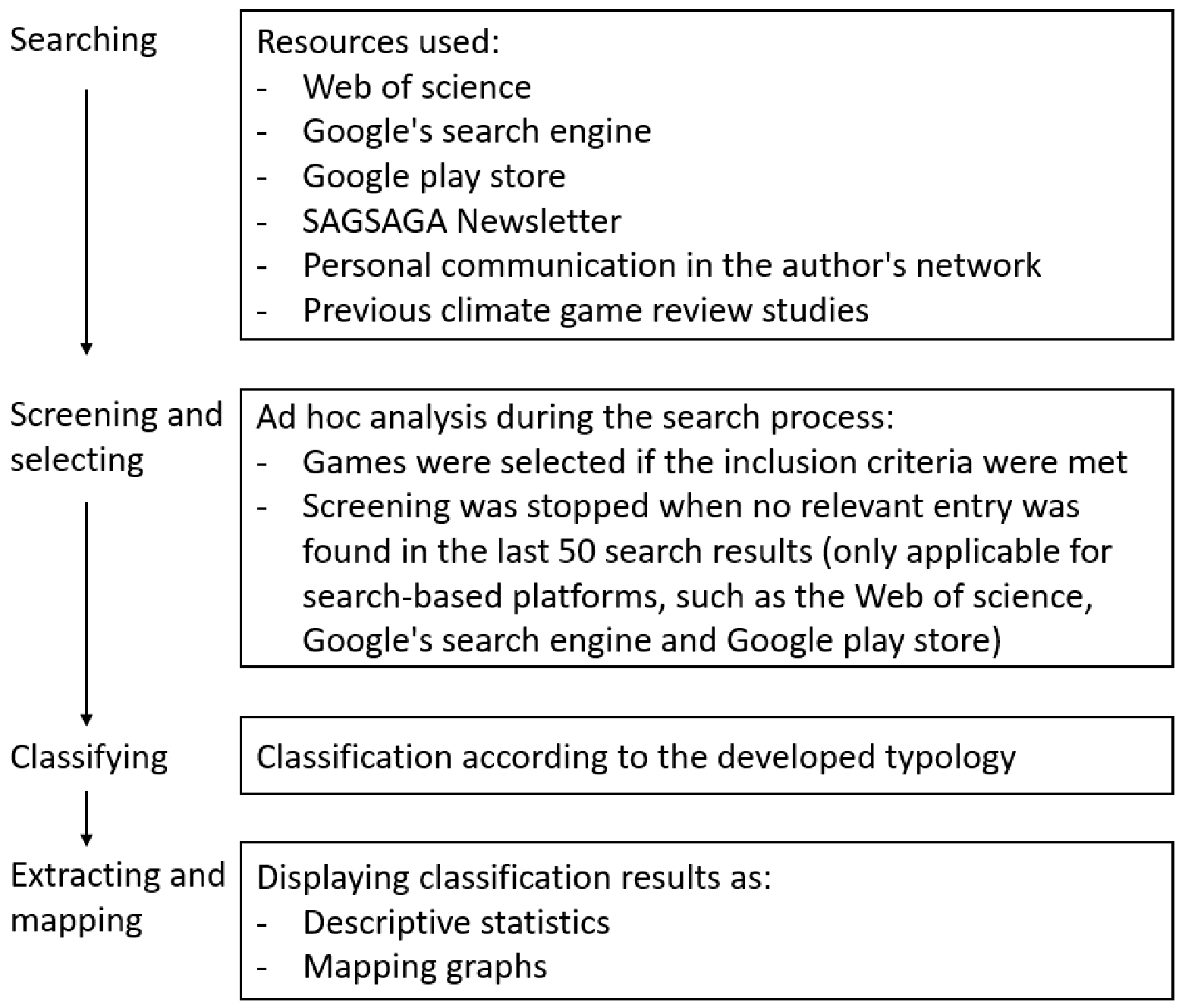
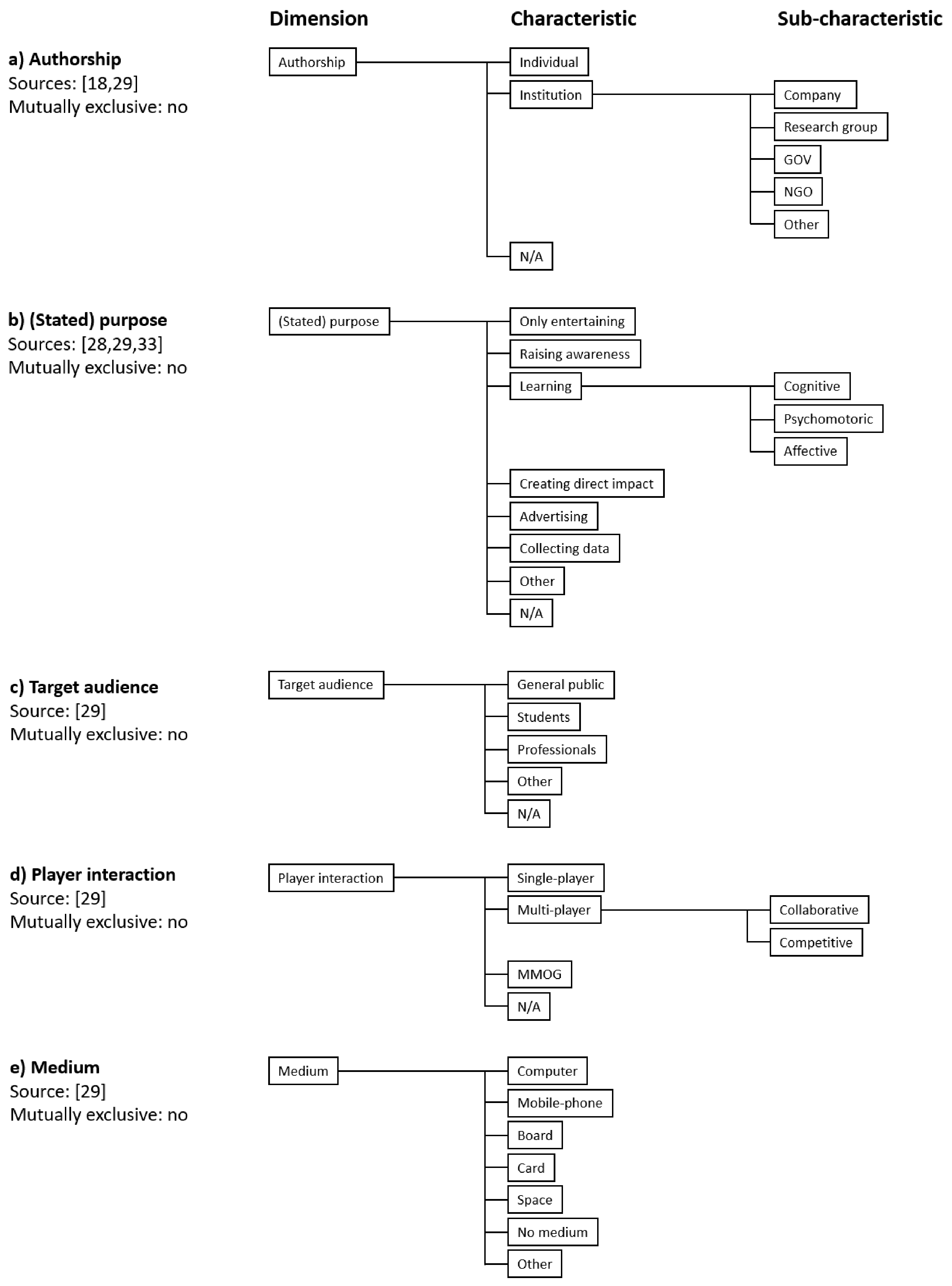

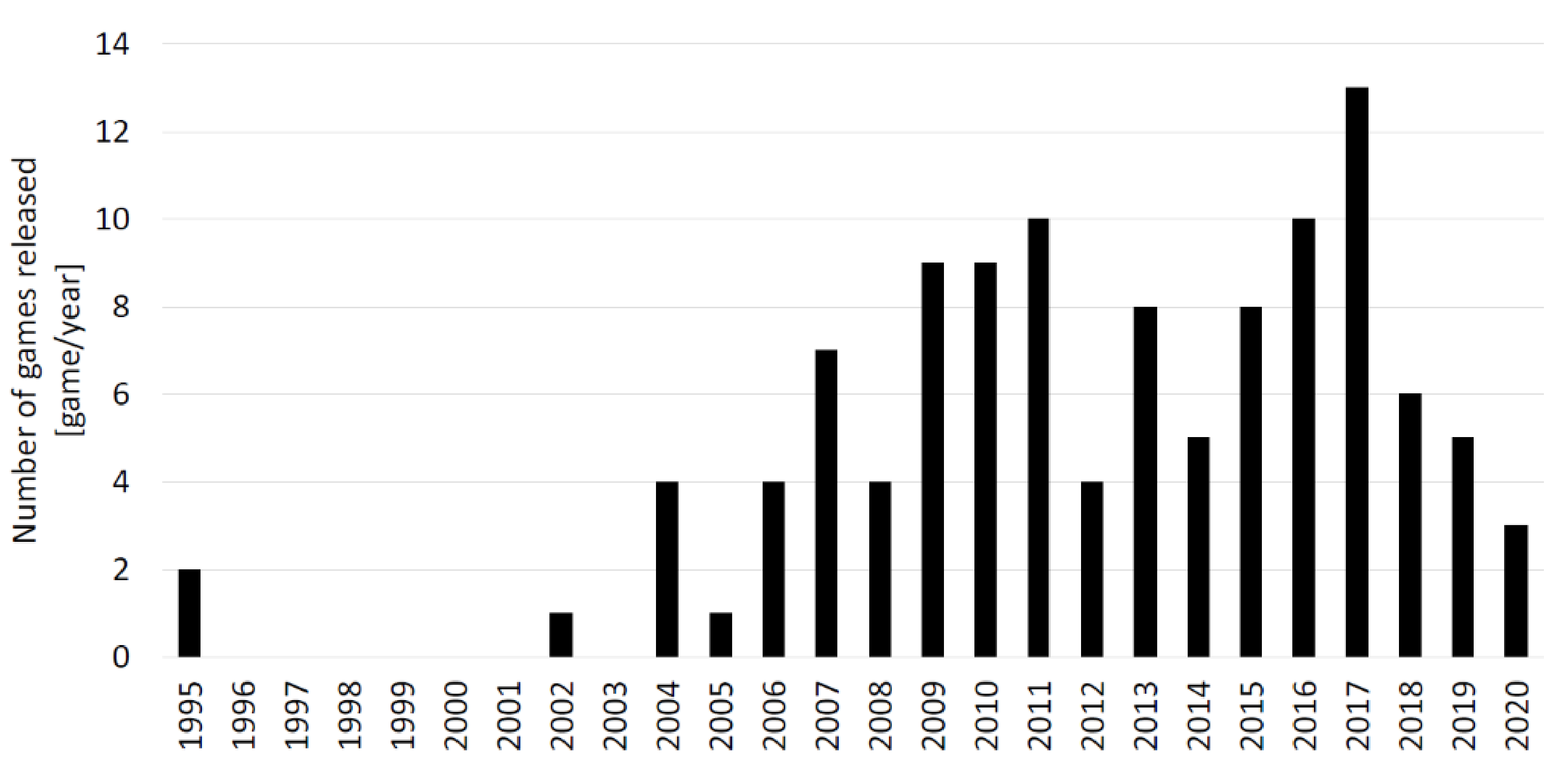
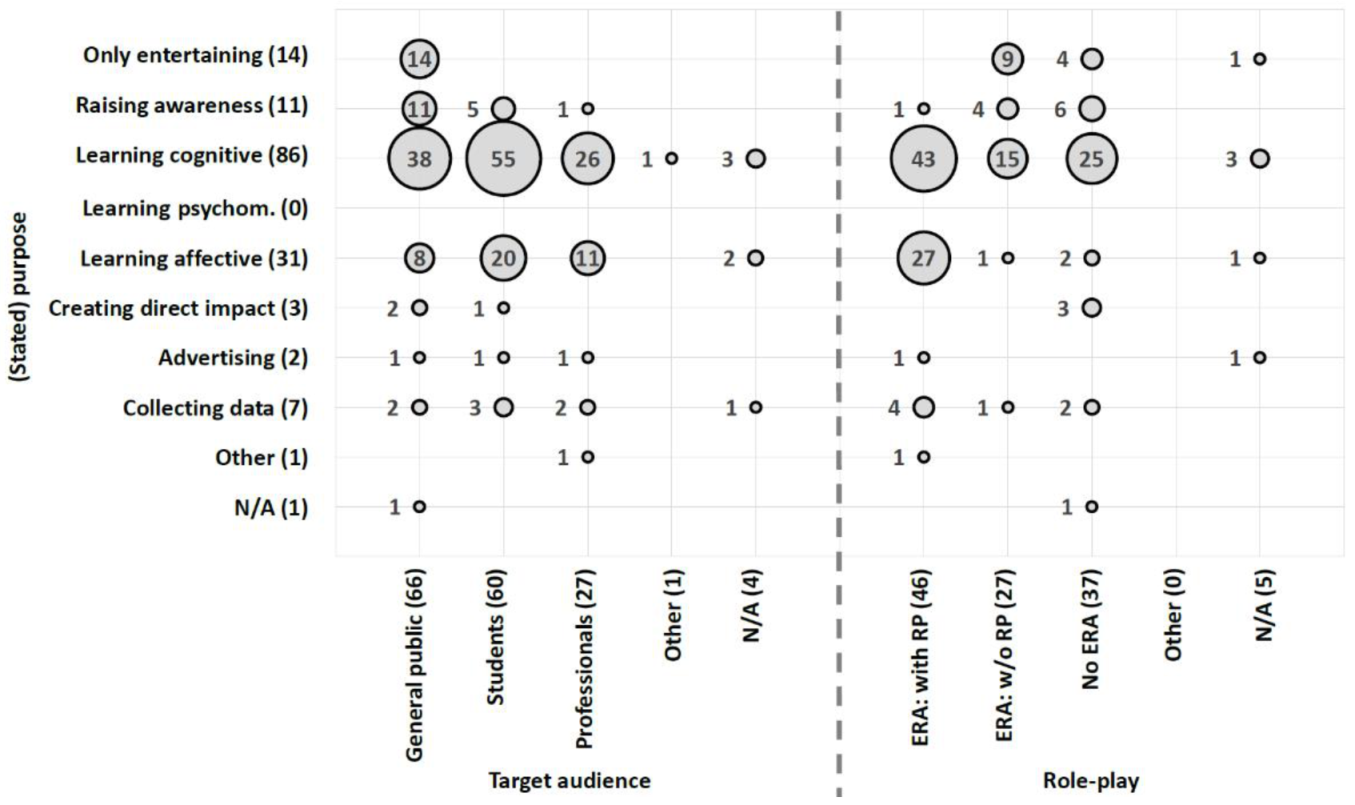
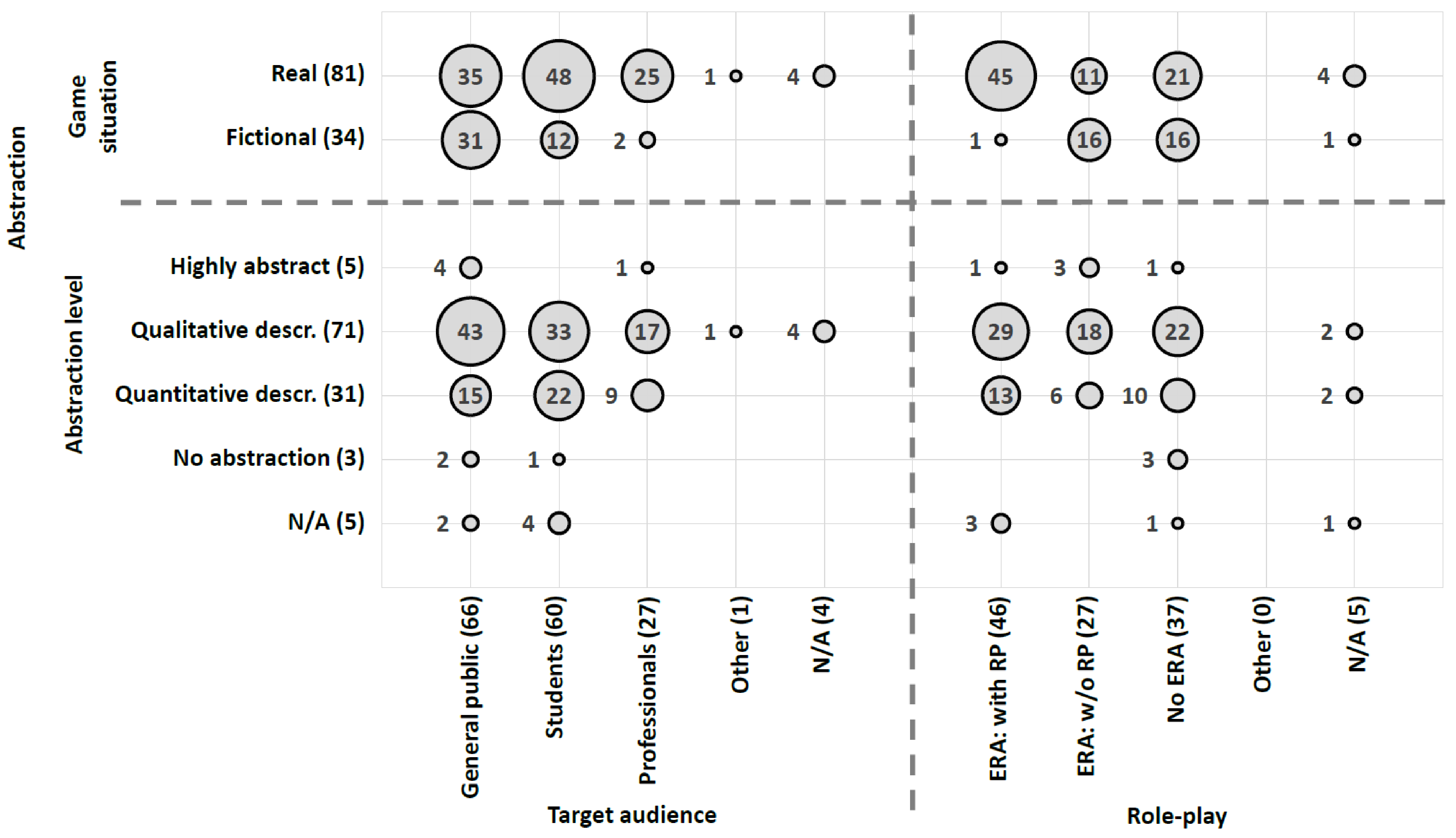

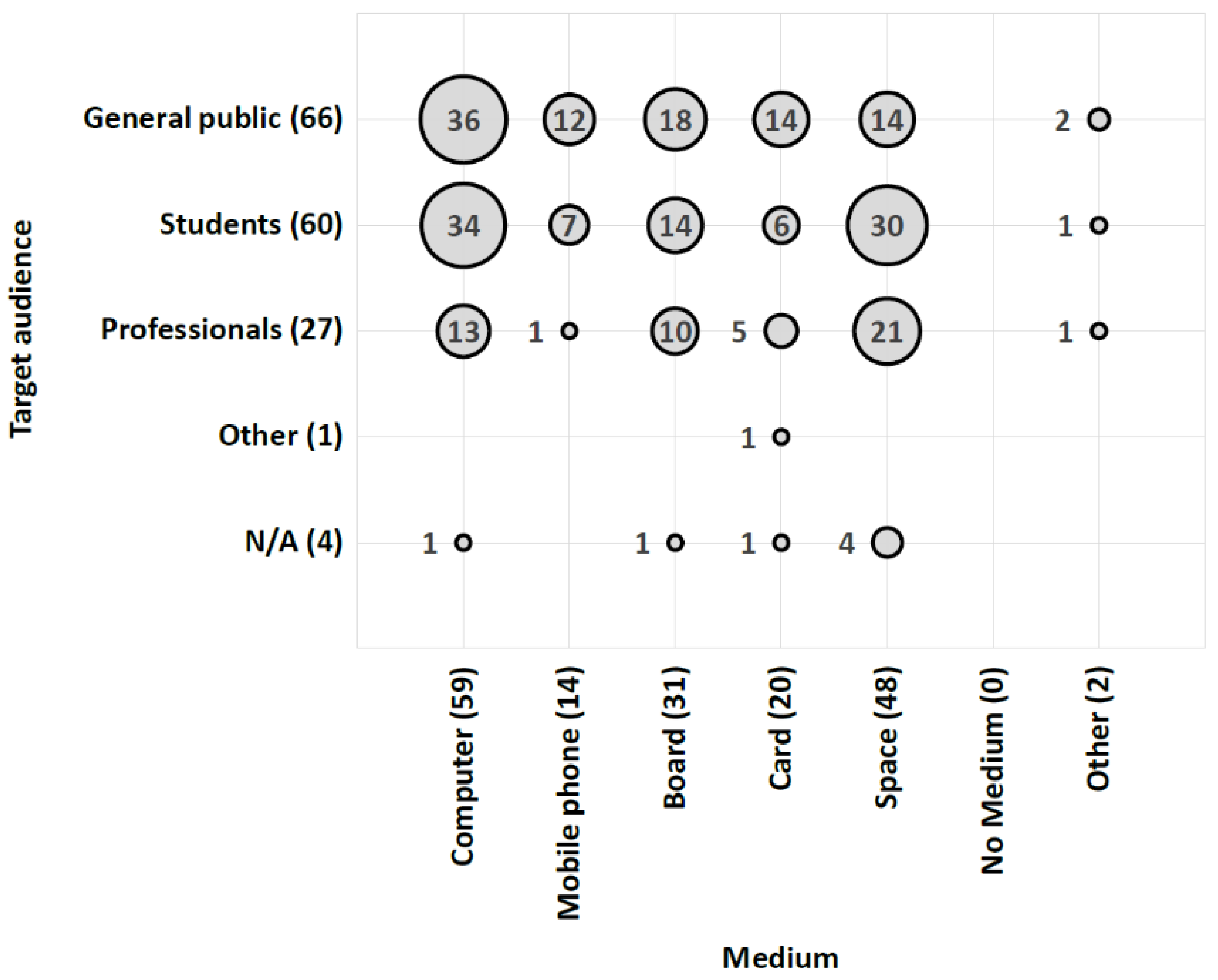
| Criterion | Inclusion | Exclusion |
|---|---|---|
| The application focuses on climate change. | Climate change is a focus aspect of the application. | The application focuses on related topics without mentioning climate change (e.g., energy, disaster risk reduction). Climate change is mentioned only in the title. |
| The application shows typical characteristics of a game. | The application allows for a game-play experience and for interaction. | The application allows for very limited interaction such as mere simulators (e.g., to calculate carbon footprints). |
| The application is not oversimplified. | The application includes a storyline, scenario, simulation or a model [26] (pp. 352–355). | The applications includes no storyline, scenario, simulation or model. Applications that are very simple in content, e.g., mere quizzes, or interactive presentations with gamification elements. |
| Release Year | Name | N |
|---|---|---|
| 1995 | Climate-change policy exercise, Susclime. | 2 |
| 2002 | Die Klimaschutzbasis. | 1 |
| 2004 | Keep cool, Energie 21, Stabilization wedges game, Climate change showdown. | 4 |
| 2005 | Winds of change. | 1 |
| 2006 | World climate, Climate challenge, V GAS, Stop disasters! | 4 |
| 2007 | Europas Klima wandeln!, triCO2lor, Operation climate control, Ecoego, Electrocity, World without oil, Planet green game. | 7 |
| 2008 | Energie für die Zukunft, Klimakonferenz-Internationale Klimapolitik, Connect2climate, War game: clut and climate change. | 4 |
| 2009 | Climate poker, Mobility, Energie Klimaschutz und Verbraucher, Climate diplomat, Keep cool online, Climate game, Cooling down, Climate health impact, Clim city. | 9 |
| 2010 | CEO2, 2050 Pathways, Cool it!, Before the storm, Grönlands Gier, Greenhouse emissions reduction role-play exercise, The global climate change game, A new beginning, Das Klimaspiel. | 9 |
| 2011 | Fate of the world, Enercities, Climate action simulation, Energetingen, d’Aquino and Bah. 2011 [39], Polar eclipse, Interactive energy and climate simulation, Losing the lake, The adventures of carbon bond, Broken cities. | 10 |
| 2012 | CO2, Cantor’s world, 2° und es wird immer heißer, Energiespardorf Bayern. | 4 |
| 2013 | Simulation of international climate regime formation, Greenify, Climate defense, Future delta 2.0, Increasing climate change resilience of urban poor communities in Asia-Pacific, Globalisierung und Global Governance, KRAFLA, Valkering et al. 2013 [40]. | 8 |
| 2014 | Go2Zero, Climate bathtube simulator, Climate Engineering-Planspiel, World rescue, Ökotopia. | 5 |
| 2015 | Carbon copy politics, Climate game, Climate action game, Lebel et al. 2016 [41], Invest in the future, Planspiel zur UN-Klimakonferenz COP21, Clim way, Energy wars: green revolution. | 8 |
| 2016 | Age of energy, Model United Nations with climate engineering, Flood resilience game, Let’s negotiate! simulation of the climate change conference, Carbon warfare, Climate challenge, Urban climate architect, Gender and climate game, Beyond Paris, Climate quest. | 10 |
| 2017 | Peak Oil, CO2peration, Sustainable delta, New shores, Paying for predictions, Sinking island, Greenhouse gas game, Was kostet die Welt: Gemeinsam gegen den Klimawandel?, Worlds future, Utah climate challenge, Act to adapt, Climate adaptation game, Global sustainability crossroads. | 13 |
| 2018 | Solar city, Energy transition game, Imagine earth, Earth remembers, Das D3-Planspiel, KlimaRallye. | 6 |
| 2019 | Climate oasis, The climate trail, Adaptive futures-the game, Escape climate change, Change the Game, Die Klimaschutz-Challenge. | 5 |
| 2020 1 | Deine Gemeinde–unser Klima, Cranky uncle, Climate vision: a role-play game. | 3 |
| N/A | The cauldron game, Operation sustain. | 2 |
| Dimension | Characteristic | Sub-Characteristic | N | % |
|---|---|---|---|---|
| Authorship | Individual/s | 12 | 10% | |
| Institution | Company | 38 | 33% | |
| Research group | 38 | 33% | ||
| GOV 1 | 11 | 10% | ||
| NGO 2 | 26 | 23% | ||
| Other | 6 | 5% | ||
| N/A 3 | 4 | 3% | ||
| (Stated) purpose | Only entertaining | 14 | 12% | |
| Awareness raising | 11 | 10% | ||
| Learning | Cognitive | 86 | 75% | |
| Psychomotoric | 0 | 0% | ||
| Affective | 31 | 27% | ||
| Creating direct action/impact | 3 | 3% | ||
| Advertising | 2 | 2% | ||
| Collecting data | 7 | 6% | ||
| Other | 1 | 1% | ||
| N/A | 1 | 1% | ||
| Target audience | General public | 66 | 57% | |
| Students | 60 | 52% | ||
| Professionals | 27 | 23% | ||
| Other | 1 | 1% | ||
| N/A | 4 | 3% | ||
| Player interaction | Single-player | 34 | 30% | |
| Multi-player | Collaboration | 62 | 54% | |
| Competition | 66 | 57% | ||
| MMOG 4 | 1 | 1% | ||
| N/A | 4 | 3% | ||
| Medium | Computer | 59 | 51% | |
| Mobile phone | 14 | 12% | ||
| Board | 31 | 27% | ||
| Card | 20 | 17% | ||
| Space | 48 | 42% | ||
| No medium | 0 | 0% | ||
| Other | 2 | 2% | ||
| Simulation | Tactical-decision simulation | 52 | 45% | |
| Social-process simulation | 36 | 31% | ||
| Other simulation | 4 | 3% | ||
| No simulation | 29 | 25% | ||
| N/A | 3 | 3% | ||
| Role-play | Explicit role assignment | With role-play | 46 | 40% |
| Without role-play | 27 | 23% | ||
| No explicit role assignment | 37 | 32% | ||
| Other | 0 | 0% | ||
| N/A | 5 | 4% | ||
| Game-play | Play-based | 12 | 10% | |
| Game-based | 101 | 88% | ||
| Other | 0 | 0% | ||
| N/A | 2 | 2% | ||
| Abstraction | Game situation | Real | 81 | 70% |
| Fictional | 34 | 30% | ||
| Abstraction level | Highly abstract | 5 | 4% | |
| Qualitative description | 71 | 62% | ||
| Quantitative description | 31 | 27% | ||
| No abstraction | 3 | 3% | ||
| N/A | 5 | 4% | ||
| Topic | Response to climate change | Mitigation | 92 | 80% |
| Adaptation | 24 | 21% | ||
| Other | 3 | 3% | ||
| N/A | 4 | 3% | ||
| Proposed lever for solutions | Individual | 26 | 23% | |
| Private organization | 14 | 12% | ||
| Public institution | 42 | 37% | ||
| Technology | 6 | 5% | ||
| Other | 0 | 0% | ||
| Not specified | 50 | 43% | ||
| Key sectors | Energy | 41 | 36% | |
| Water services | 10 | 9% | ||
| Transport | 15 | 13% | ||
| Other primary & secondary economic activities | 15 | 13% | ||
| Recreation/tourism | 7 | 6% | ||
| Insurance & financial services | 2 | 2% | ||
| Health | 3 | 3% | ||
| Other | 17 | 15% | ||
| N/A | 43 | 37% | ||
| System level | Global | 33 | 29% | |
| Several countries | 12 | 10% | ||
| Country | 9 | 8% | ||
| City | 21 | 18% | ||
| Community | 13 | 11% | ||
| Household | 8 | 7% | ||
| Individual | 6 | 5% | ||
| Other | 13 | 11% | ||
| N/A | 13 | 11% |
Publisher’s Note: MDPI stays neutral with regard to jurisdictional claims in published maps and institutional affiliations. |
© 2021 by the authors. Licensee MDPI, Basel, Switzerland. This article is an open access article distributed under the terms and conditions of the Creative Commons Attribution (CC BY) license (http://creativecommons.org/licenses/by/4.0/).
Share and Cite
Gerber, A.; Ulrich, M.; Wäger, F.X.; Roca-Puigròs, M.; Gonçalves, J.S.V.; Wäger, P. Games on Climate Change: Identifying Development Potentials through Advanced Classification and Game Characteristics Mapping. Sustainability 2021, 13, 1997. https://doi.org/10.3390/su13041997
Gerber A, Ulrich M, Wäger FX, Roca-Puigròs M, Gonçalves JSV, Wäger P. Games on Climate Change: Identifying Development Potentials through Advanced Classification and Game Characteristics Mapping. Sustainability. 2021; 13(4):1997. https://doi.org/10.3390/su13041997
Chicago/Turabian StyleGerber, Andreas, Markus Ulrich, Flurin X. Wäger, Marta Roca-Puigròs, João S. V. Gonçalves, and Patrick Wäger. 2021. "Games on Climate Change: Identifying Development Potentials through Advanced Classification and Game Characteristics Mapping" Sustainability 13, no. 4: 1997. https://doi.org/10.3390/su13041997
APA StyleGerber, A., Ulrich, M., Wäger, F. X., Roca-Puigròs, M., Gonçalves, J. S. V., & Wäger, P. (2021). Games on Climate Change: Identifying Development Potentials through Advanced Classification and Game Characteristics Mapping. Sustainability, 13(4), 1997. https://doi.org/10.3390/su13041997






